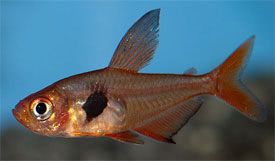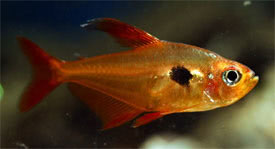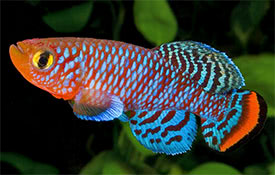
 Magyarul / Hungarian
Magyarul / Hungarian


- Scientific name: Hyphessobrycon sweglesi
- Synonyms: Megalamphodus sweglesi
- Common name: Red phantom tetra
- Group: Characins
- Habitat: South America; in the Rio Muco and the Rio Meta, Columbia.
- Size: 4 cm
- Biotope: Shaded areas with heavy vegetation.
- Social behavior: A peaceful, schooling fish that is recommended for a community tank. This fish can be kept in a pair or groups. Do not keep singly, as single fish lose color, stop eating, and often die. Keep with fish that can tolerate slightly lower water temperatures. Males often fight battles, but neither fish is harmed.
- Diet: Flake, live, insect larvae, Brine Shrimp, Tubifex.
- Breeding: Hard
- Tank: Minimum 80 litres
- Population: 5-6 fishes for 80 litres
- Decoration: A well-planted tank (particularly with floating plants), subdued lighting and a dark substrate.
- Temperature: 20-24°C
- pH: 6,5-7,2.
- Hardness: 4,5-8,5 NK°
- Lifespan: 3-5 years
Description: The dorsal fin of the male is tall and elongated. It is multicolored; usually red, black, and white. The female's dorsal fin is also elongated and is red and black. The body color ranges from brown to blood-red depending on the fish's condition. A red line extends from the gill cover to the tail. The head is brighter red than the rest of the body. A large black, comma-shaped mark is located behind the gill cover, but it lessens in intensity with age. The anal and pectoral fins are elongated and like the rest of the fins, red in color.
Males are slimmer with larger and more elaborate fins. The female has a multicolored dorsal fin.
Use a breeding tank with muted light, a pH of 5.5-6.0, and a water hardness of 1-2 dH. Spawning takes place among plants during morning hours. Eggs are susceptible to fungus, so treat accordingly. The reddish-brown eggs hatch in 1-2 days and fry are free-swimming after 4-5 more. The fry are slow-growing and are delicate. Start feeding with small live foods.




